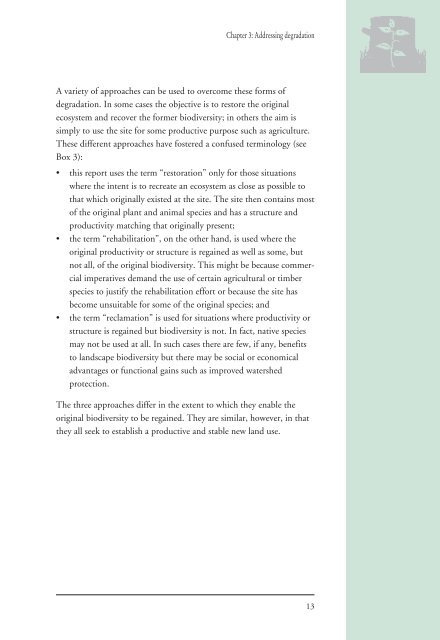Rehabilitation and Restoration Of Degraded Forests (PDF) - IUCN
Rehabilitation and Restoration Of Degraded Forests (PDF) - IUCN
Rehabilitation and Restoration Of Degraded Forests (PDF) - IUCN
Create successful ePaper yourself
Turn your PDF publications into a flip-book with our unique Google optimized e-Paper software.
Chapter 3: Addressing degradation<br />
A variety of approaches can be used to overcome these forms of<br />
degradation. In some cases the objective is to restore the original<br />
ecosystem <strong>and</strong> recover the former biodiversity; in others the aim is<br />
simply to use the site for some productive purpose such as agriculture.<br />
These different approaches have fostered a confused terminology (see<br />
Box 3):<br />
• this report uses the term “restoration” only for those situations<br />
where the intent is to recreate an ecosystem as close as possible to<br />
that which originally existed at the site. The site then contains most<br />
of the original plant <strong>and</strong> animal species <strong>and</strong> has a structure <strong>and</strong><br />
productivity matching that originally present;<br />
• the term “rehabilitation”, on the other h<strong>and</strong>, is used where the<br />
original productivity or structure is regained as well as some, but<br />
not all, of the original biodiversity. This might be because commercial<br />
imperatives dem<strong>and</strong> the use of certain agricultural or timber<br />
species to justify the rehabilitation effort or because the site has<br />
become unsuitable for some of the original species; <strong>and</strong><br />
• the term “reclamation” is used for situations where productivity or<br />
structure is regained but biodiversity is not. In fact, native species<br />
may not be used at all. In such cases there are few, if any, benefits<br />
to l<strong>and</strong>scape biodiversity but there may be social or economical<br />
advantages or functional gains such as improved watershed<br />
protection.<br />
The three approaches differ in the extent to which they enable the<br />
original biodiversity to be regained. They are similar, however, in that<br />
they all seek to establish a productive <strong>and</strong> stable new l<strong>and</strong> use.<br />
13

















